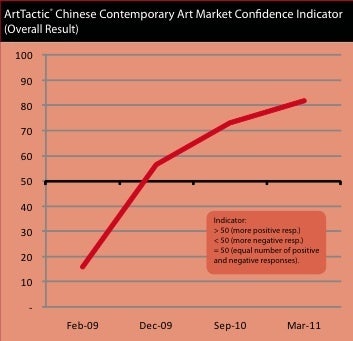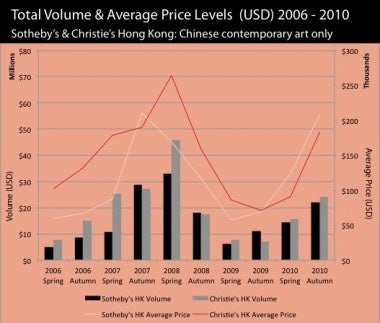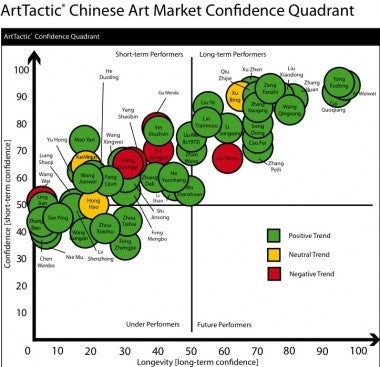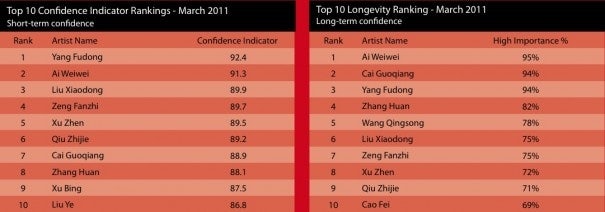Chinese Contemporary Primary Market Confidence Indicator Rose Whopping 28 Percent Since September 2010#

Confidence at an All-Time High (Graph: ArtTactic)
ArtTactic’s newest survey of the Chinese contemporary art market reflects what many in the art world have suspected over the past six months: the confidence of Chinese collectors in contemporary art has now made China the “most confident” art market in the world. According to ArtTactic’s overall Chinese Contemporary Art Market Confidence Indicator, confidence rose 12 percent since September 2010, with the Chinese Contemporary Primary Market Confidence Indicator rising a full 28 percent in the same amount of time. This, according to ArtTactic, has seen China surpass the American, European and Indian art markets to become the world’s top market in terms of Market Confidence. Currently, ArtTactic places China 21 percent above the US & European market Confidence Indicator, and 34 percent above the Indian Confidence Indicator.
As the survey notes, confidence in the Chinese contemporary art market has recovered quickly since February 2009, with 75 percent of experts surveyed saying they believe the market will continue to climb in the next six months.

Chinese Contemporary Art: Towards A Second Boom (Graph: ArtTactic)
The Confidence Indicator of the Chinese contemporary art market now sits at 81, an all-time high. While this is important news, it’s not entirely surprising. Last month, a TEFAF report identified China as the world’s second-largest art market, overtaking the United Kingdom. Additionally, domestic Chinese auction houses have really begun flexing their muscles over the past couple of years, procuring artwork by some of the country’s top blue-chip artists and overtaking both Sotheby’s and Christie’s in terms of auction volume of contemporary Chinese art. While ArtTactic is concerned about the sustainability of the growth seen in the mainland China art market over the past two years, it points out that distinctions must be made between the Mainland market and the Hong Kong market.
To look into this, ArtTactic’s Risk and Speculation Barometer measured expert perceptions about mainland China and Hong Kong, with mainland China’s risk barometer coming in 49 percent higher than Hong Kong. This, according to the survey, reinforces ArtTactic’s argument that the Chinese contemporary art market is “on a two-track journey,” driven by different market dynamics (e.g., domestic and global) and different types of buyers (e.g., new vs. discriminating collectors). This isn’t an entirely new observation, however. As Jing Daily pointed outfollowing ArtTactic’s fall 2010 confidence report, domestic Chinese auction houses like Poly and China Guardian have their own “favored artists,” which aren’t necessarily favored by the Hong Kong outposts of Sotheby’s or Christie’s. As prices for these artists soar in mainland China but not in Hong Kong, we clearly see the effect of the “two-track” journey.
One of the key factors driving confidence in the Chinese contemporary art market is regional economic growth, ArtTactic finds, noting that the Economic Indicator (which measures expert opinion on current and short-term outlook for the Chinese economy) has fallen four percent since September 2010 yet the reading remains at 77. This implies that positive sentiment outweighs negative sentiment 3-to-1. For the sake of comparison, China’s Economic Indicator is currently 60 percent higher than the equivalent Economic Indicator for the US & European art market. The Expectation Indicator (which predicts confidence in the Chinese Economy for the next 6 months) is now 5 percent higher than the Current Indicator – which means there is little to suggest that experts foresee any imminent change to the current situation, and that the market will, in all likelihood, stay on a positive trajectory.

ArtTactic is most bullish about artists like Yang Fudong, Ai Weiwei, and Zeng Fanzhi (Graph: ArtTactic)
A key difference in the mainland China and Hong Kong auction markets is the primacy of the high-end in Hong Kong. ArtTactic notes a major boost in confidence among respondents about the $1 million+ price segment, with 65 percent saying they feel that this segment will continue to climb, compared with 44 percent in September 2010. Experts were even more confident about the next segment down, $500,000-1 million, with 67 percent saying they are confident about this slice of the market, up from only 29 percent in September 2010. These findings are almost to be expected, however, since the market share (in terms of lots) of the higher end of the Chinese contemporary sales in Hong Kong increased last year from five percent in spring 2010 to seven percent in autumn. A similar trend was noted in the mainland China market, though artists sometimes differed.
Looking at contemporary Chinese “blue-chips” in terms of value, last autumn the top 10 lots at Sotheby’s Hong Kong accounted for more than 72 percent of total auction value. At Christie’s Hong Kong, the top 10 accounted for 42 percent of the total, with works by Zeng Fanzhi making up four of these 10 lots. In their autumn sales last year, Poly and China Guardian sold 12 lots above $1 million, for a total value of $35.6 million. This was almost 80% higher than sales at Sotheby’s and Christie’s Hong Kong, which posted 10 lots above $1 million, for a total value of $19.8 million (all excluding buyer’s premium).
In terms of artist confidence, ArtTactic observes a number of recent changes to the long-term confidence ranking. Cai Guo-qiang, Ai Weiwei, Zhang Huan and Yang Fudong still make up the Top 4, with photographer Wang Qingsong entering the Top 10 for the first time at #5, followed by Liu Xiaodong in 6th place. In terms of long-term sentiment, 75 percent of the artists (39 out of 52) have seen a positive increase in long term confidence in their markets. Artists who have seen a positive increase in their long-term outlook since September 2010 include Wang Qingsong, Cao Fei and Lin Tianmiao. ArtTactic goes on to point out that Yin Xiuzhen, Liu Ye, Gu Wenda and Liu Wei make up the top of the short-term confidence indicator, but uncertainty lingers around their long-term longevity.

Short- and Long-Term Longevity Indicators put artists like Yang Fudong and Ai Weiwei in the top (Graph: ArtTactic)